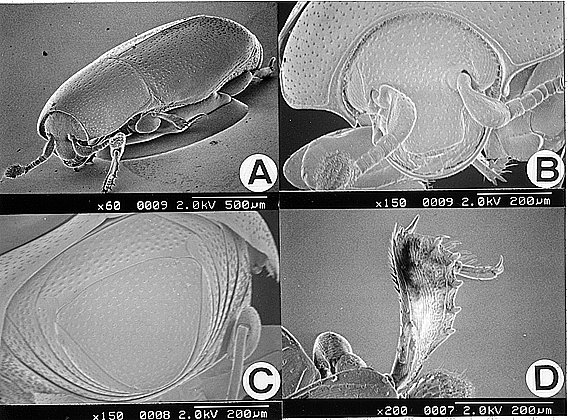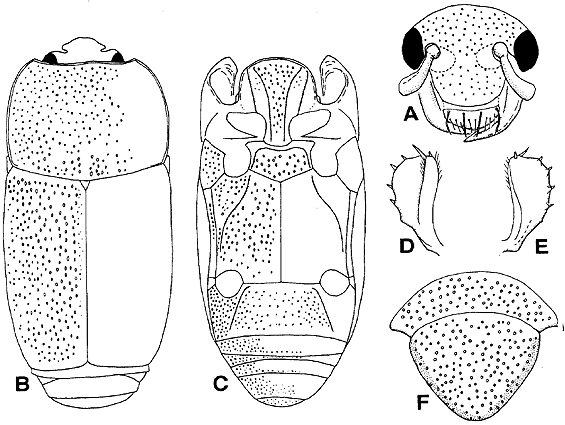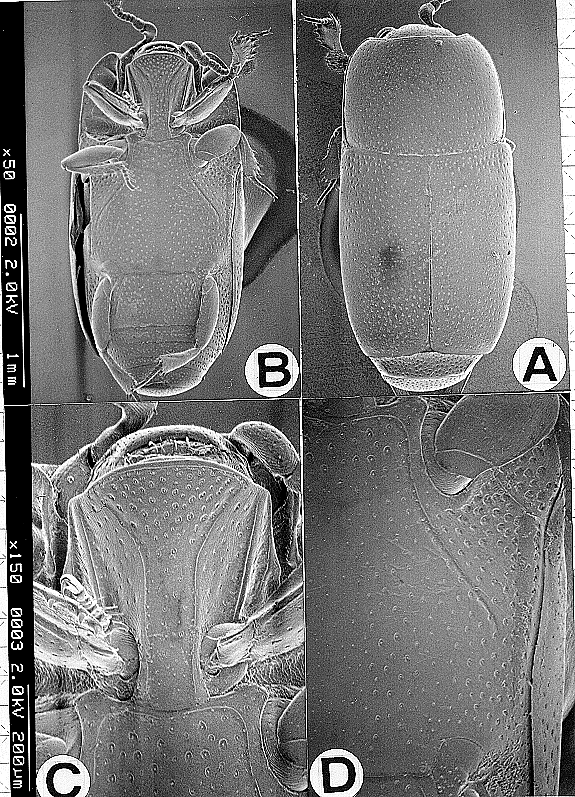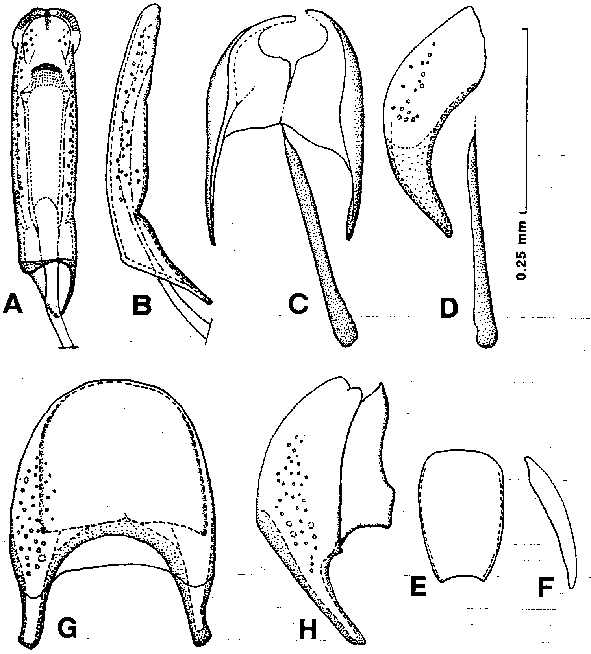
Holotype (SEHU). Male. Pointe-mounted; genitalia dissected; genitalia in balsam on one plastic slide; labeled as follows: 1. Japan: Nansei Iss., Ishigaki Is. (Truck trap), 13. Jul. 1997, K. Takahashi. 2. " M. Oara, No-9865. 3. Holo-type, Macroabraeus akiyamai n. sp., Det. M. Ohara. (red label). Paratypes (SEHU). Two females and 1 ex. [Nansei Isles]. Same data of holotype (1 female); Same locality of holotype (1 female, 13/xi/1995; 1 ex., sex undetermined, 3-13/viii/1996), K. Takahashi.
Body convex, cylindrical, black and shining; tibiae brown; antennae and tarsi light brown. Body length (in mm.), PPL 1.56-1.75 (Holotype: 1.68), PEL 1.55-1.8 (1.55), APW 0.49-0.5 (0.5), PPW 0.78-0.83 (0.8), PL 0.58-0.63 (0.58), EL 0.93-0.95 (0.93), EW 0.80-0.94 (0.8), ProW 0.48-0.58 (0.48), ProL 0.12-0.18 (0.18), PyL 0.28-0.33 (0.33), PTL 0.30-0.33 (0.33), MSTL 0.28-0.32 (0.30), MTTL 0.35-0.38 (0.35).
Head (Fig. 27A, 29B) sparsely and evenly punctate, the punctures separated by 25 times their diameter. Labrum transverse oblong, with 4 long and 8 short setae, its anterior margin semicircular.
Pronotal sides (Fig. 27B, 28A) nearly parallel on basal 3/4, convergent forwards on apical 1/3. Marginal stria well impressed and complete laterally and anteriorly, the basal ends shortly bent inwardly; disk sparsely and evenly covered with coarse punctures which are separated by about 23 times their diameter.
Epipleural and elytral marginal stria absent. Disk of elytra
sparsely covered with coarse punctures that are coarse as on the
pronotum.
Propygidium (Fig. 27F, 29C) densely covered with coarse punctures that are separated by 0.75 (0.51) times their diameter. Pygidium densely and coarsely punctate, the punctures are little sparser than the propygidium.
Anterior margin of median portion of prosternum (Fig. 27C, 28C) regularly rounded, with a marginal stria that is well impressed. Keel broad moderately compressed, sparsely covered with coarse punctures; the posterior margin truncate. Carinal striae well impressed completely, the anterior half gradually divergent apically. Descending lateral stria deeply impressed, the outer ridge carinate.
Anterior margin of mesosternum (Fig. 27C, 28C, D) feebly emarginate
medially, its marginal stria carinate and complete; disk sparsely
covered with coarse punctures that are separated by 25 times
their diameter. Meso-metasternal suture lightly impressed, angulate
at middle. Intercoxal disk of metasternum sparsely covered with
coarse, deep and longitudinal punctures that are separated by
14 times their diameter, the punctures becoming smaller and
sparser in lateral area; lateral disk sparsely and coarsely punctate,
the punctures being sparser and finer posteriorly; lateral-metasternal
stria well impressed, carinate, extending obliquely and posteriorly,
reaching near middle of metasternal-metepisternal suture. Disk
of meta-epimeron densely covered with coarse and round punctures
that are separated by 0.51 times their diameter.
Intercoxal disk of 1st abdominal sternum (Fig. 27C) sparsely covered with punctures, which are a little finer than those of the metasternum; its sides completely striate and carinate.
Protibia (Fig. 27D, E, 29D) dilated, its outer margin with 5 denticle (spinulae), the basal-most fine. Mesotibia with 4 spines on outer margin. Metatibia with 2 spines on apical angle.
Male genitalia as shown in Fig. 30. Apical 1/5 of aedeagus
expanded; basal piece absent. Spiclue slender and not divided
into two parts.
Distribution. Japan (Nansei Isles: Ishigaki-jima Is.).
Etymology. This species is named for late Mr. Koyo Akiyama, in recognition of his interest in the natural history of Coleoptera and his encouragement to those who wish to study it.
Remarks. Macroabraeus akiyamai is very distinctive and differs obviously from all Japanese species in the family by the small and cylindrical body. This new species resembles superficially Paromalus spp. in the subfamily Dendrophilinae, but differs in wanting the prosternal lobe. This species was colleced by truck trap (a driving motor truck with an insect net on the roof).
